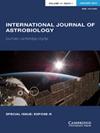Children of time: the geological recency of intelligence and its implications for SETI
IF 1
4区 物理与天体物理
Q3 ASTRONOMY & ASTROPHYSICS
引用次数: 0
Abstract
Of all species on Earth, only one – Homo sapiens – has developed a technological civilization. As a consequence, estimates of the number of similar civilizations beyond Earth often treat the emergence of human-like intelligence or ‘sophonce’ as an evolutionary unicum: a contingent event unlikely to repeat itself even in biospheres harbouring complex brains, tool use, socially transmitted behaviours and high general intelligence. Here, attention is drawn to the unexpected recency and temporal clustering of these evolutionary preconditions to sophonce, which are shown to be confined to the last ≤102 million years. I argue that this pattern can be explained by the exponential biotic diversification dynamics suggested by the fossil record, which translated into a nonlinearly expanding range of cognitive and behavioural outcomes over the course of Earth's history. As a result, the probability of sophonce arising out of a buildup of its enabling preconditions has been escalating throughout the Phanerozoic. The implications for the Silurian hypothesis and the search for extraterrestrial intelligence (SETI) are discussed. I conclude that the transition from animal-grade multicellularity to sophonce is likely not a rate-limiting step in the evolution of extraterrestrial technological intelligences, and that while H. sapiens is probably the first sophont to evolve on Earth, on macroevolutionary grounds it is unlikely to be the last.时间之子:智能的地质时代性及其对 SETI 的影响
在地球上的所有物种中,只有一个——智人——发展出了技术文明。因此,对地球以外类似文明数量的估计往往将类人智能或“索菲特”的出现视为进化的独特性:即使在拥有复杂大脑、工具使用、社会传播行为和高一般智力的生物圈中,这种偶然事件也不太可能重演。在这里,我们注意到这些进化先决条件的意外近代性和时间聚类,这些条件被证明局限于最近≤1.02亿年。我认为,这种模式可以用化石记录显示的指数生物多样化动态来解释,这在地球历史进程中转化为认知和行为结果的非线性扩展范围。因此,在整个显生宙,由于其有利的先决条件的积累而产生的二龙宙的可能性一直在不断上升。讨论了志留纪假说和地外智慧生物(SETI)的意义。我的结论是,从动物级别的多细胞生物到高等生物的转变,在外星技术智能的进化过程中,可能不是一个限制速度的步骤,而且,尽管智人可能是地球上进化的第一个高等生物,但从宏观进化的角度来看,它不太可能是最后一个。
本文章由计算机程序翻译,如有差异,请以英文原文为准。
求助全文
约1分钟内获得全文
求助全文
来源期刊

International Journal of Astrobiology
地学天文-地球科学综合
CiteScore
3.70
自引率
11.80%
发文量
45
审稿时长
>12 weeks
期刊介绍:
International Journal of Astrobiology is the peer-reviewed forum for practitioners in this exciting interdisciplinary field. Coverage includes cosmic prebiotic chemistry, planetary evolution, the search for planetary systems and habitable zones, extremophile biology and experimental simulation of extraterrestrial environments, Mars as an abode of life, life detection in our solar system and beyond, the search for extraterrestrial intelligence, the history of the science of astrobiology, as well as societal and educational aspects of astrobiology. Occasionally an issue of the journal is devoted to the keynote plenary research papers from an international meeting. A notable feature of the journal is the global distribution of its authors.
 求助内容:
求助内容: 应助结果提醒方式:
应助结果提醒方式:


